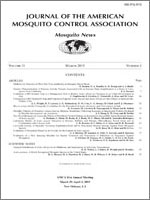The objective of this study was to determine the larvicidal activity of an active compound isolated from Cercis chinensis heartwood and its structurally related analogs against 4th-stage Aedes aegypti, Culex pipiens pallens, and Ae. togoi. The larvicidal compound of C. chinensis was isolated with the use of various chromatographic techniques and identified as analogs of 1,4-naphthalenedione. Based on the median lethal concentration (LC50) values of commercially procured analogs against Ae. aegypti larvae, the most toxic analog was 2-bromo-1,4-naphthalenedione (1.19 µg/ml); followed by 5-hydroxy-1,4-naphthalenedione (1.72 µg/ml); 2-methyl-1,4-naphthalenedione (9.12 µg/ml); 2-hydroxy-1,4-naphthalenedione (10.76 µg/ml); and 2-methoxy-1,4-naphthalenedione (12.50 µg/ml). Similar results were observed against Cx. p. pallens and Ae. togoi larvae with 1,4-naphthalenedione analogs. These results also showed that 1,4-naphthalenedione analogs were less toxic than the organophosphate pirimiphos-methyl. Nonetheless, naturally occurring C. chinensis–derived materials and 1,4-naphthalenedione analogs have potential for development as mosquito larvicidal agents.
How to translate text using browser tools
1 March 2015
Larvicidal Activity of Naturally Occurring Naphthalenedione and its Structurally Related Analogs Against Three Mosquito Species
Ju-Hyun Jeon,
Min-Gi Kim,
Hoi-Seon Lee
ACCESS THE FULL ARTICLE
It is not available for individual sale.
This article is only available to subscribers.
It is not available for individual sale.
It is not available for individual sale.
Ae. togoi
Aedes aegypti
Cercis chinensis
Culex pipiens pallens
mosquito larvicidal activity





